
There is an estimated 480,000 farm dams in Australia (Price et al, 2003) of which thousands have failed and/or pose significant safety threats to downstream communities. The Australian National Committee on Large Dams (ANCOLD) in 1992 reported a 23% failure rate for farm dams in NSW (ANCOLD, 1992, p.11). In Tasmania a number of private/farm dams have failed in the past 80 years with serious consequences (Ingles, 1984; Pisaniello, 1997), and currently some 500 of the 8000 registered dams pose significant safety risks (DPIWE, 2005, p.21; Ditchfield, 2008). In Victoria around 1000 of the 300,000 farm dams are very dangerous (Murley, 1987; Lake & Bond, 2006, p.290), and Lewis and Harrison (2002) reported that at least ten significant failures have occurred in Victoria in the last decade.
Small dam failures internationally have had disastrous consequences. For example, in China the Shimantan and Banquia dams failed in 1975 due to the cumulative failure of 60 smaller upstream dams, resulting in the death of 230,000 people (Fu & Quing, 1998). In the United States, the Kelly Barnes Lake dam, only 8 metres high, failed in 1977 killing 39 people (Hiser & McDonald, 1989); the Evans and Lockwood dams, which were only around 5 metres high and held only 89 ML and 39 ML of water respectively, both collapsed in 1989, killing 2 people (Graham, 1999). In Indonesia, the Situ Gintung earthen dam, only 10 metres high, failed by overtopping in March 2009 killing around 100 people and causing widespread damage (The Associated Press, 2009; BBC News, 2009). Graham’s (1999) study of dam failures in the US that resulted in fatalities from 1960 to 1998 found that dams less than 15 metres high (ie typical height range of smaller “private/farm” dams) caused 88% of deaths [ie 88% of those attributable to dam failure]. The study also found that dams less than 6 metres high (ie very small dams) which failed caused 2% of the deaths. These events demonstrate that without appropriate design, construction, maintenance and surveillance, poorly managed small dams pose both significant individual and cumulative threats and can cause considerable human, property and environmental losses.
In most countries, including Australia, ongoing owner responsibility exists under Common Law to maintain dams according to current standards (Pisaniello & McKay, 2007). In Australia, these standards are set by ANCOLD (2000a, 2000b, 2003). However, many jurisdictions have found that it is not enough to rely solely on Common Law responsibility to protect downstream communities, property and the environment from poor dam safety management practices. Some form of government-implemented dam safety accountability and assurance policy is required where privately-owned dams exist (Pisaniello & McKay, 2005; 2007). ANCOLD states:
“A role of government is to enact legislation to protect the community. Legislation should establish regulatory authorities that ensure dam owners, and potential dam owners, are taking appropriate actions in regard to dam safety” (ANCOLD, 2003, p.3).
Policy responses in Australia include NSW, Victoria, Queensland and Tasmania making good legislative progress. However, more work needs to be done in certain States, particularly concerning cumulative/cascade safety threats posed by smaller catchment dams (Pisaniello & McKay, 2005; 2006; 2007). For example, the remit of dams supervised needs to be increased, and effective and efficient administration of laws is vital for private dam safety assurance policy to be successful. South Australia and Western Australia have been altogether too complacent with private dam safety policy (Pisaniello, 1997; Pisaniello & McKay, 2007). The seriousness of the problem with such ‘policy-limited’ States was partly demonstrated by Pisaniello and McKay (1998a; 2005) concerning dam spillway capabilities.
“Beyond legislation, guidance on the responsibility of dam owners and on dam safety management, both at the sites of dams and downstream of them, is provided in a recently reviewed Australian Emergency Manual (Commonwealth of Australia, 2009). This document is one of a series of best-practice guides on the management of flooding in Australia.”
This paper provides “follow-up” historic, illustrative and comparative evidence on a broader range of private dam safety management practices, issues and threats in South Australia based on case studies that have extended over a 12-year period. Lessons and guidance, relevant to any jurisdiction, are provided for achieving ‘adequate’ private dam safety accountability and assurance policy that minimises dam failure emergencies.
South Australia has over 22,000 farm dams in the Mount Lofty Ranges alone (McMurray, 2004, p.5). Pisaniello (1997) found that at least 100 of these represent considerable hazard potential. However, dam safety assurance policy remains absent.
A Bill on dam safety was introduced into Parliament in 1985 but lapsed. Several years later the Bill was reintroduced but unfortunately the new Government entered into a "mode of deregulation", so the Bill was not implemented (Sheuard, 1993). Nevertheless, the need for private dam safety assurance policy continued to be expressed on many fronts, for example:
“The Construction of farm dams……around Adelaide is a potential cause of concern…….lack of power to ensure safety during and after construction has in the past and will in the future, inevitably lead to failures and the exacerbation of flood flows in the river systems…..urges the Government to introduce legislation and controls and the establishment of safety standards for the construction and maintenance of farm dams” (Flood Warning Consultative Committee SA, 1990).
Following the severe floods throughout the Mount Lofty Ranges in the latter months of 1992, a study discovered that farm dam failures provided additional problems and contributed to damage costs (Harrison, 1992). In response, the Hydrological Society of South Australia held a seminar on farm dams in April, 1993. Its proceedings suggested that it was time to "jump start" a Dam Safety Bill again. However, no further progress was made (Sheuard, 1993).
A study (LDC & SMEC, 1995; Kazarovski, 1996) of the Kangaroo Creek Dam, one of SA’s largest public dams, found the peak inflow would increase four-fold if all small dams in the catchment failed at the same time in a 1-in-200 years flood event. This event would exceed Kangaroo Creek Dam’s spillway capability putting downstream communities at unacceptable risk. The small dams’ cumulative failure was a reasonable assumption given that Pisaniello and McKay (2005; 2007) found most small dams cannot even pass the 1-in-100 years design flood event. The Kangaroo Creek study demonstrated the considerable cumulative risk of farm dam population failures in larger catchments. It also urged the South Australian Government to introduce laws to regulate farm dam construction and safety. The warnings were unheeded.
Pisaniello (1997) undertook case studies of hazardous private dams in South Australia to test their condition, general maintenance and spillway capabilities. The results on the spillway capabilities (Pisaniello & McKay, 1998a; 2005) provided empirical evidence on the urgent need for a dam safety policy. Policy response, however, was still not forthcoming despite much guidance made available in this area (see Pisaniello & McKay, 2007). The results on the condition and general maintenance of the dams are reported for the first time below to further reinforce this need.
Currently, local councils, in providing development authorisation under the Development Act 1993, have only very limited control over the siting and construction of new dams. Natural Resources Management (NRM) Boards under the NRM Act 2004 do have some control over farm dams, but this is mainly concerning water allocations. The NRM Act provides for a permit/licence process to build new dams or alter existing dams which may restrict the dam’s storage capacity or require “environmental flow” release from the dam. The issuing authority is not obliged to consider questions of building or flood safety.
The South Australian Government could have included dam safety assurance measures in its water laws when it developed the integrated NRM Act 2004. Yet the issue is still not considered critical enough by policy makers. Since the early 1990s, extensive safety studies and subsequent upgrading have been commissioned for most government-owned dams (Pisaniello, 1997; Pisaniello & McKay, 2006). By failing to establish some form of safety accountability and assurance policy on managing potentially hazardous private dams, South Australia is, in effect, unconsciously devaluing the lives of people living downstream of these dams compared to the lives of those living downstream of public dams to which attention has been given. The Government should be held accountable for this inequity. It appears that the necessary policy response in South Australia will only be activated once a disastrous, fatal dam failure occurs. This is not a proactive approach to the problem and unfortunately for downstream communities the potential consequences could be devastating.
Pisaniello (1997) undertook case studies of hazardous private dams in South Australia to test their condition and general maintenance in the absence of dam safety policy. These results are reported here and contribute to the identification of trends in such a “policy limited” State.
In 1995, eleven hazardous earthen farm dams were randomly selected for investigation in the Mount Lofty Ranges (see Table 1). The following criteria were adopted when selecting the dams:
Table 1. Summary of the Basic Characteristics of the Sample Dams.
Dam No. |
When Built (year) |
Max. Height (m) |
Storage Cap.(ML) |
Hazard Rating |
Why the Assigned Hazard Rating? |
|---|---|---|---|---|---|
1 |
1968 |
7.8 |
147 |
High |
Located directly above a township |
2* |
1990 |
9.2 |
83 |
High |
Number of residential households close downstream |
3* |
1939 |
10.5 |
249 |
High |
Large historic township close downstream |
4* |
1967 |
9.0 |
89 |
High |
Residential households directly below |
5 |
pre 1970 |
8.0 |
162 |
High |
Sewage treatment plant close downstream |
6* |
1975 |
10.7 |
50 |
High |
Number of residential households close downstream |
7 |
1980 |
8.1 |
177 |
Sig. |
Much valuable property downstream |
8 |
pre 1970 |
7.5 |
60 |
Sig. |
Other storages located downstream—domino effect |
9 |
pre 1970 |
5.5 |
54 |
Sig. |
Much valuable property downstream |
10 |
pre 1970 |
6.6 |
103 |
Sig. |
Another storage and much property downstream |
11* |
1965 |
8.4 |
70 |
Sig. |
Other storages located downstream—domino effect |
*The only 5 dams for which permission could be gained to re-inspect in 2007
Over 100 dams were large enough to satisfy the first criterion based on GIS data. Most of these were at least “Significant” hazard following assessment based on the second criterion. Dam owners were contacted to request property access, but many refused. Eventually 11 owners permitted access subject to confidentiality of their names and addresses. Fortunately, six of the 11 dams were amongst those confirmed as “High Hazard” as summarised in Table 1.
Detailed inspections were made of each sample dam’s general condition and apparent maintenance in late spring/early summer 1995. In 2007 permission was given to revisit only five of the dams in Table 1 (marked by asterisk). Site inspections re-affirmed their hazard ratings against the updated ANCOLD (2000b) guidelines and provided results for comparison with the 1995 results: hence, 12-year case studies. The inspections explored whether dams met the basic ANCOLD (1994) requirements, which are now found in ANCOLD (2003). The publication “Your Dam - An Asset or a Liability” (DCNR, 1993) was adopted as a guide in the visual inspections and assessments. Any potential problems or basic limitations associated with owner management practices were noted.
The condition of the dams and apparent levels of maintenance varied but many basic deficiencies were common. A brief description and assessment of three of the five sample dams inspected in both 1995 and 2007 is provided below. A summary of all the inspections together with a comparative analysis follows.
Upon first inspection of this High hazard dam in 1995, physical obstructions, including a walkway bridge and sandbags, were present across the spillway restricting its potential capacity (Figure 1). The top section of the bank contained localised depressions and cracks approximately 5 mm wide by 100 mm deep indicating shrinkage. Trees had grown out of the embankment and harsh obscuring vegetation covered the entire downstream face of the embankment violating ANCOLD requirements. Overall, the dam’s condition in 1995 was poor. Despite pointing out these deficiencies to the owner, they still existed in 2007 (see Figure 2). The dam had obviously received minimal or no maintenance in the 12-year period.
Figure 1. Dam No.2 in 1995 showing the spillway blocked by a walk-way bridge and sand bags, and trees allowed to grow out of the crest.
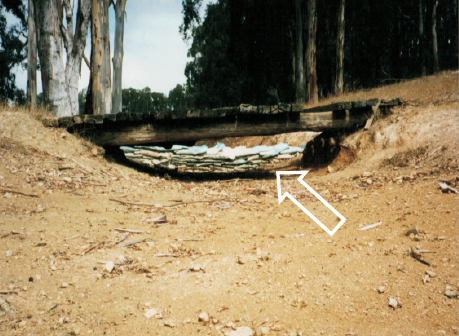
Figure 2. Dam No.2 in 2007 showing a close-up of the sand bags used to block the spillway.
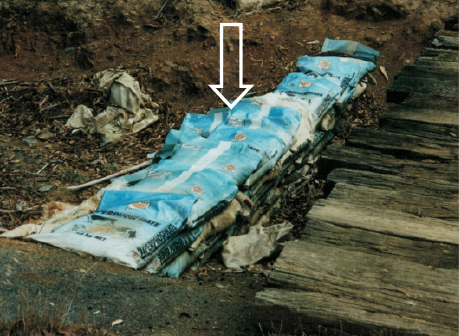
Inspection of this High hazard dam in 1995 revealed some maintenance activity. Good uniform protection existed along the upstream face of the embankment and the crest was well graded and uniform (Figure 3). The spillway was clear of vegetation but contained a large mound of dumped earth causing obstruction and reducing capacity (see Figure 3). These circumstances violate ANCOLD requirements and the local council repeatedly warned the owner of these problems (Seamen, 1995). In 2007 the dam’s condition had worsened. As illustrated in Figure 4, vegetation grew out of embankment as well as within the spillway, and the mound of soil blocking the spillway remained.
Figure 3. Dam No. 4 in 1995 showing the spillway blocked by a mound of dirt. There is also dense vegetation allowed to grow on the downstream face of the embankment.
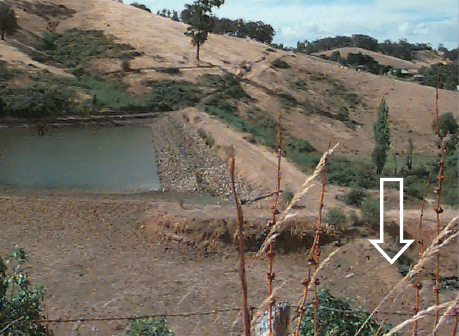
Figure 4. Dam No. 4 in 2007 showing the spillway still blocked by a mound of dirt, but now shrubs and vegetation are growing in the spillway and along the upstream face of the embankment.

This High hazard reservoir was clearly unsafe in 1995 due to the manner in which the overflow undercut and weakened the dam wall, see Figure 5. The owner had been warned by the local council to correct the problem by re-diverting the overflow (Seamen, 1995). In 2007 the dam had not been upgraded (see Figure 6). Without legislation, the council is powerless to ensure compliance. The dam in 1995 was otherwise found to be in reasonable condition, having a clear spillway, excellent grass cover over the embankment and a uniform, well graded crest (see Figure 5). Unfortunately, in 2007 these conditions did not prevail because harsh vegetation completely blocked the spillway and grew out of the embankment (Figure 6).
Figure 5. Dam No. 6 in 1995 showing the spillway undercutting and weakening the dam wall. The embankment was otherwise well maintained.
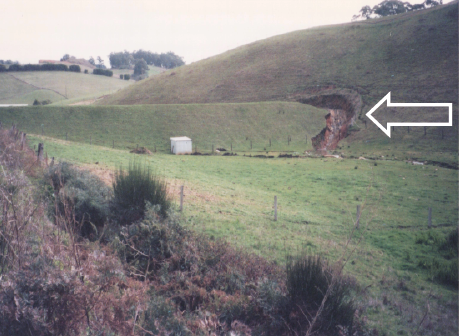
Figure 6. Dam No. 6 in 2007 showing the spillway still undercutting the dam wall. Dense vegetation is also now allowed to grow out of the embankment and to completely block the spillway.
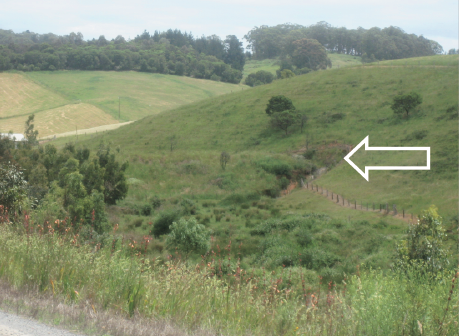
Figures 1 to 6 well typify problems identified for the other 2 sample dams investigated over 12 years and also the 6 dams inspected only in 1995. Most private owners either underestimate or ignore the risks and hazards associated with their dams and are depriving the structures of necessary maintenance and upgrading. To quantify the extent of the problem in the study area, the results have been analysed by rating the condition and associated maintenance level of each dam as either: (1) Good, (2) Reasonable, (3) Poor, or (4) Very Poor. Dams rated either poor or very poor were considered “unacceptable” in respect to ANCOLD (1994 & 2003) guidelines. This analysis is provided in Table 2.
Table 2. Rated Summary of Condition / Maintenance Level of Sample Dams over 12 Years.
Dam No. |
Hazard Rating |
1995 Condition / Maintenance Level Rating (Good, Reasonable, Poor, or Very Poor) |
1995 Acceptability per ANCOLD (1994) Guidelines |
2007 Condition/ Maintenance Level Relative to 1995 per ANCOLD (1994/2003) Guidelines |
|---|---|---|---|---|
1 |
High |
Good |
Acceptable |
n/a |
2* |
High |
Very Poor |
Unacceptable |
Worse |
3* |
High |
Poor |
Unacceptable |
Unchanged |
4* |
High |
Poor |
Unacceptable |
Much Worse |
5 |
High |
Poor |
Unacceptable |
n/a |
6* |
High |
Very Poor |
Unacceptable |
Worse |
7 |
Sig. |
Reasonable |
Acceptable |
n/a |
8 |
Sig. |
Very Poor |
Unacceptable |
n/a |
9 |
Sig. |
Very Poor |
Unacceptable |
n/a |
10 |
Sig. |
Very Poor |
Unacceptable |
n/a |
11* |
Sig. |
Very Poor |
Unacceptable |
Worse |
*The only 5 dams for which permission could be gained to re-inspect in 2007
The results in Table 2 demonstrate that most of the selected dams in 1995 were deficient in some ways. In fact, nine (82%) were rated unacceptable, five of these being “High Hazard”. As the basis of selecting the dams was not their lack of maintenance, it was expected that more than two of the dams would show compliance with ANCOLD requirements, but this was not the case. For the 5 dams re-inspected in 2007, where 4 of these are High hazard, the deficiencies remain in every case and in fact worsened in most cases. This confirms that these owners have, in the past 12 years, ignored the warnings on their dams’ risks and hazards, as well as their Common Law responsibility to maintain them.
This provides strong evidence that the status of private dam safety in South Australia is extremely poor and unacceptable in the absence of adequate dam safety assurance policy. It is a matter of when rather than if a serious private dam failure will occur in South Australia. Consequently the need for policy is critical.
This section provides guidance on developing private dam safety accountability and assurance policy that is in line with international best practice. Useful reference to Tasmanian “model” policy and key-actor feedback is included.
The dam safety management and assurance practices of Australia, USA, Canada, United Kingdom, Finland, Portugal and South Africa were reviewed by Pisaniello (1997); see also Pisaniello and McKay (1998b; 2007). Schemes to control dam safety management vary between and within countries but key components in certain practices exist. Jurisdictions have regulated dams as small as 1.8 metres high (Michigan, USA) and with a minimum storage capacity of 25 ML (UK) regardless of dam hazard potential. New Zealand has also recently joined this list of countries, implementing dam safety legislation to regulate dams as small as 3 metres high and with a minimum storage capacity of only 20 ML (Building Act 2004; Building (Dam Safety) Regulations 2008). Clearly these overseas countries recognise the need to assure the safety of even the smallest of dams.
Pisaniello and McKay (1998b; 2007) provide detailed policy models and criteria for determining “appropriate” dam safety assurance policy. This can help guide the action that any jurisdiction currently lacking in private/farm dam safety accountability and assurance policy should take.
Tasmania has over 30% of Australia’s total water storage capacity, including thousands of farm dams. It is the only State to acknowledge that, due to their cascade/cumulative threats, even small, low hazard dams must be registered and supervised, albeit to a modest extent. To this end, Tasmanian dam safety policy provides some form of monitoring of all dam storages down to as small as 1ML. Pisaniello and McKay (2006) provide more specific details of this “model” approach.
Cost burdens to small dam owners can be minimised by making available affordable design/review processes, for example, the simple Tasmanian reporting pro-forma (see Pisaniello and McKay, 2006) and the Pisaniello (1997) cost-effective spillway design/review procedure (see Pisaniello et al 1999). The Tasmanian government commissioned preliminary development of this procedure in July 2008. When fully developed, regulators can use it as a spillway safety checking tool. Dam owners and engineers can also use it as a cost-effective tool to review/design spillways and fulfil reporting requirements.
The Water Management Group of the Department of Primary Industries and Water (DPIW) is responsible for administering the Tasmanian dam safety policy. The problems discovered in the 12-year South Australian study were discussed with DPIW in June and July 2008. DPIW revealed that South Australian landholders’ bad dam management and spillway blocking practices also occur in Tasmania, and were more common prior to the recent law reforms. DPIW also confirmed that the general intention of landholders purposefully blocking their spillways is to store more water than may otherwise be allowed by entitlement. DPIW will include the following statement in its forthcoming Guidelines for the Construction of Earth-Fill Dams:
“In no circumstances should a spillway be blocked by either logs becoming wedged in the spillway or the spillway being purposefully filled to increase the capacity of the dam” (DPIW, 2007, p.15).
Rigorous implementation of the policy is critical - it usually takes an inspection by the authority and instruction to cease and remedy in order to stamp out such practice.
Low hazard dams are specifically targeted when potential cascade or cumulative failure scenarios arise. Such scenarios are common. DPIW carefully considers each scenario and adjusts hazard ratings of smaller dams when appropriate, thus imposing stronger surveillance, reporting, and safety standards. Inevitably, as dams throughout Tasmania are discovered and come onto the register, the cumulative threats posed by small dams in large catchments will be reduced. Tasmania’s approach shows that governments can ensure that not only individual potentially hazardous dams are kept safe, but also the cumulative safety threats posed by small dams are kept in check.
If dams are not managed properly, then all dams, large and small, high and low hazard, pose considerable safety risks because of the potential for failure. Such risks can arise at either the individual and/or cumulative level within catchments. These risks can be magnified by the attitudes, behaviours and practices of private dam owners as well as the attitudes and responses of policy makers.
In South Australia, the attitude of farm dam owners is clearly one of complacency. Their on-farm behaviour and practices over the past 12 years show that they underestimate the importance of a dam’s spillway and dam maintenance and safety in general. Policy makers are also complacent. The absence of any policy responses despite numerous research and warnings over many years indicates a dangerously reactive rather than proactive approach in South Australia. It is tantamount to “waiting for a disaster to happen” and does not set a good example for others to follow.
Relying only on the Common Law responsibility for landholders to maintain dams, and giving them more time, awareness and encouragement does not work. Adequate farm dam safety accountability and assurance can only be provided by implementing appropriate legislative policies. Tasmania provides a good example of an Australian jurisdiction that is addressing private/farm dam safety issues well, including the management of both individual and cumulative dam safety threats. Since it is the role of government to protect the community, government must provide such policies which assure the community that owner accountability and participation protect them from unacceptable dam safety management practices. The evidence and guidance provided in this paper should strongly encourage such action in South Australia and any other ‘policy deficient’ jurisdictions.
The 1995 component of this study was undertaken as part of the Pisaniello (1997) doctoral studies thanks to an APRA scholarship and supervision by Prof John Argue and Prof Jennifer McKay at the University of South Australia. The 2007 component of this research was made possible through financial support from the UniSA Research Office. The Australian Research Council is also acknowledged for its recent Discovery Project funding to enable further research into cumulative catchment threats. Thanks to Prof Roger Burritt from the Centre for Accounting, Governance and Sustainability at UniSA for his recent interest and support for this research, and to Mr Arthur Spassis for his valuable field work and assistance. Much appreciation is extended to the Tasmanian Department of Primary Industries and Water for the information provided on that State’s dam safety situation: Mr Sam Ditchfield for participating in valuable discussions and contributing key facts; and Mr Lud Schmidt and Dr Alan Harradine for their ongoing support. Thanks also to Dr Chas Keys for contributing useful information on the recent Commonwealth flood manuals.
ANCOLD (1986), Guidelines on Design Floods for Dams, Australian National Committee on Large Dams.
ANCOLD (1992), Status of Dam Safety in Australia, Bulletin No.91, Australian National Committee on Large Dams, pp. 9-29.
ANCOLD (1994), Guidelines on Dam Safety Management, Australian National Committee on Large Dams.
ANCOLD (2000a). Guidelines on Selection of Acceptable Flood Capacity for Dams, Australian National Committee on Large Dams.
ANCOLD (2000b). Guidelines on Assessment of the Consequences of Dam Failure, Australian National Committee on Large Dams.
ANCOLD (2003) Guidelines on Dam Safety Management, Australian National Committee on Large Dams.
BBC News (2009) ‘Indonesia dam burst kills dozens’ 27 March 2009, www.news.bbc.co.uk/2/hi/asia-pacific/7967205.stm, accessed 30 April 2009.
Building Act 2004 (New Zealand)
Building (Dam Safety) Regulations 2008 (New Zealand)
Commonwealth of Australia (2009) Emergency Management Planning for Floods Affected by Dams, 2nd edition, Attorney-General’s Department (available at www.em.gov.au).
DCNR (1993), Your Dam - an Asset or a Liability, Guidelines Prepared by the Rural Water Corporation, Dept. of Conservation and Natural Resources, Victoria.
Development Act 1993 (SA)
Ditchfield, S. (2008), Personal Communication, Dams Safety Engineer, Dept of Primary Industries and Water, Tasmania, June 2008.
DPIW (2007), Guidelines for the Construction of Earth-Fill Dams, Dept of Primary Industries and Water, Tasmania, September, Draft Only.
DPIWE (2005), ‘Report on the Operation of the Water Management Act 1999’, Dept of Primary Industries, Water and Environment, Tasmania, Report by Water Resources Division.
Flood Warning Consultative Committee, SA (1990), Flood Warning Management Plan for South Australia, July, pp. 26-27.
Fu, S. & Qing, D. (1998), A profile of dams in China, In The River Dragon Has Come! The Three Gorges Dam and the Fate of China’s Yangtze River and its People, Thibodeau, J. G. and Williams, P. B. (eds), Probe International and International Rivers Network, Chapter 2.
Graham, W. J. (1999), A Procedure for Estimating Loss of Life Caused by Dam Failure, United States Dept of Interior, Bureau of Reclamation, Dam Safety Office, Report DSO-99-06, Denver, Colorado.
Harrison, J.F. (1992), Central Hills Region Councils - Study of Flooding on 30th August, 1992 and 8th October, 1992, District Council of Stirling, SA, October, pp. 1-15.
Hiser, W. & McDonald, L. (1989), Dam Safety, Water Supply and Resources Conf. Proc., Nov. 1988, Sydney, NSW: 163-171.
Ingles, O. G. (1984), A Short Study of Dam Failures in Australia, 1857-1983, Civil Engineering Systems Journal, Vol. 1, June, pp. 190-194.
Kazarovski, P. (1996), ‘Farm Dams do not Have Impact on Large Floods or do They?’ Proc 23rd Hydrology and Water Resources Symposium, Hobart, Australia, 21-24 May, pp. 725–726.
LDC & SMEC (1995), ‘River Torrens Flood Hydrology Study’ Lange Dames Campbell (SA) Pty. Ltd and Snowy Mountains Engineering Corporation: A Technical Report for SA Engineering & Water Supply Department, Ref. No. SA485, June, two volumes, pp. 2-3, 40 and 43.
Lake P.S. & Bond N.R. (2006), ‘Australian Futures: Freshwater ecosystems and human water usage’, Futures 39 (2007), pp. 288-305.
McMurray, D. (2004), Farm Dam Volume Estimations from Simple Geometric Relationships, Dept of Water, Land and Biodiversity Conservation, Govt of South Australia, Report No. DWLBC 2004/48.
Murley, K. (1987), ‘Referable Dams in Victoria – Spillway Inadequacy’ ANCOLD Bulletin No. 76, April 1987, pp. 24-26.
Natural Resources Management Act 2004 (SA)
Pisaniello, J.D. (1997), Analysis and Modelling of Private Dam Safety Assurance Policy and Flood Capability Design/Review Procedures, PhD Thesis, University of South Australia.
Pisaniello, J. D., Argue, J. R. & McKay, J. M. (1999), ‘Flood Capability Design/Review of Dams on Small Catchments – A Simple and Cost-effective Regionalised Procedure’ Australian Journal of Water Resources, Vol. 3, No. 2, pp. 177-188.
Pisaniello, J.D. & McKay, J.M. (1998a), 'The Need for Private Dam Safety Assurance Policy - A Demonstrative Case Study', The Australian Journal of Emergency Management, Vol. 13, No. 3, pp. 46-49.
Pisaniello, J.D. & McKay, J.M. (1998b), ‘Models of Appropriate Practice in Private Dam Safety Assurance’ Water Policy, Vol. 1, No. 5, pp. 525-550.
Pisaniello, J .D. & McKay, J.M. (2005), ‘The need for private dam safety assurance policy-demonstrative case studies 10 years later’, The Australian Journal of Emergency Management, Vol. 20, No. 3, pp. 15-21.
Pisaniello, J.D. & McKay, J. M. (2006), ‘The Need for Private Dam Safety Assurance: a follow-up ‘model’ policy from Tasmania’, The Australian Journal of Emergency Management, Vol. 21, No. 2, pp. 45-51.
Pisaniello, J.D. & McKay, J.M. (2007), 'A Tool to Aid Emergency Managers and Community in Private Dam Safety Appraisal’, Disasters, International Journal of Disaster Studies, Policy and Management, Vol. 31, No. 2, pp. 176-200.
Price, J., Lewis, B. & Rutherford, I. (2003), ‘Water Quality in Small Farm Dams’, Proc 28th International Hydrology and Water Resources Symposium, IEAust, Wollongong, NSW, 10-14 Nov. 2003.
Seaman, D. (1995) Personal Communication, City of Onkaparinga CEO, June 1995.
Sheuard, N. (1993), ‘Dam Safety Requirements’, Proceedings of the Seminar on Farm Dams hosted by Hydrological Society of South Australia, Hahndorf, April 7, 1993, pp. 43- 46.
The Associated Press (2009) ‘Death toll rises to 96 in Indonesia dam failure’, 29 March 2009, www.msnbc.msn.com/id/29937788/, accessed 30 April 2009.
Dr John Pisaniello has multi-disciplinary interests, with honours degrees in Civil Engineering and Law. John is currently a Senior Research Fellow in the School of Commerce and Leader of the Sustainable Law and Engineering Group within the Centre for Accounting, Governance and Sustainability at the University of South Australia. John’s research aim is to ensure engineering/policy/law systems are cost-effective and “user-friendly” while in line with current best practice, and promote equity, sustainability and safety in areas such as water resources and conservation, dam safety and management, planning, development and environmental law, renewable energy, and public health and safety assurance.
Email contact: john.pisaniello@unisa.edu.au.